AMD Ryzen 7 8700G and Ryzen 5 8600G Review: Zen 4 APUs with RDNA3 Graphics
by Gavin Bonshor on January 29, 2024 9:00 AM EST- Posted in
- CPUs
- AMD
- APUs
- Phoenix
- 4nm
- Zen 4
- RDNA3
- AM5
- Ryzen 8000G
- Ryzen 7 8700G
- Ryzen 5 8600G
CPU Benchmark Performance: Rendering
Rendering tests, compared to others, are often a little more simple to digest and automate. All the tests put out some sort of score or time, usually in an obtainable way that makes it fairly easy to extract. These tests are some of the most strenuous in our list, due to the highly threaded nature of rendering and ray-tracing, and can draw a lot of power.
If a system is not properly configured to deal with the thermal requirements of the processor, the rendering benchmarks are where it would show most easily as the frequency drops over a sustained period of time. Most benchmarks, in this case, are re-run several times, and the key to this is having an appropriate idle/wait time between benchmarks to allow for temperatures to normalize from the last test.
Some of the notable rendering-focused benchmarks we've included for 2024 include the latest CineBench 2024 benchmark and an update to Blender 3.6 and V-Ray 5.0.2.
We are using DDR5-5200 memory as per the JEDEC specifications on the Ryzen 7 8700G and Ryzen 5 8600G, as well as DDR4-3200 on the Ryzen 7 5700G and Ryzen 5 5600G. The same methodology is also used for the AMD Ryzen 7000 series and Intel's 14th, 13th, and 12th Gen processors. Below are the settings we have used for each platform:
- DDR5-5200 CL44 - Ryzen 8000G
- DDR4-3200 CL22 - Ryzen 5000G
- DDR5-5600B CL46 - Intel 14th & 13th Gen
- DDR5-5200 CL44 - Ryzen 7000
- DDR5-4800 (B) CL40 - Intel 12th Gen
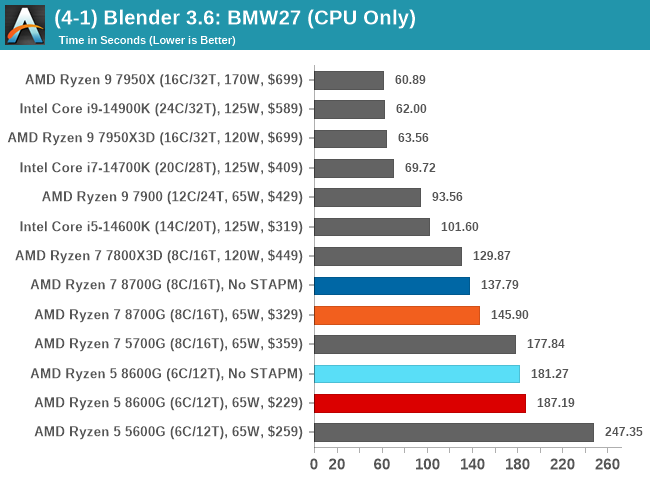
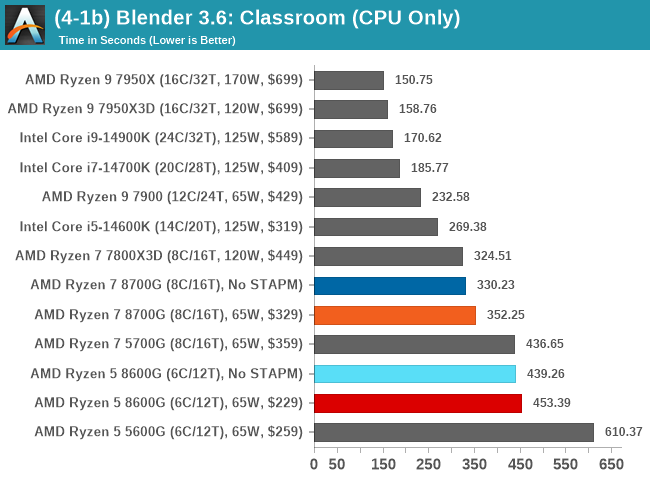
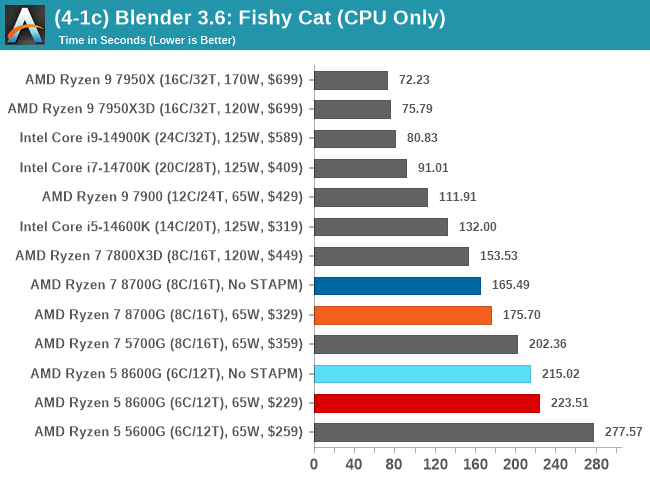
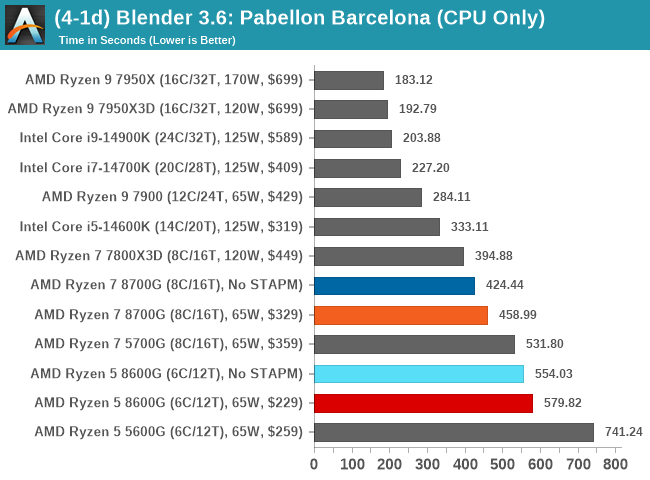

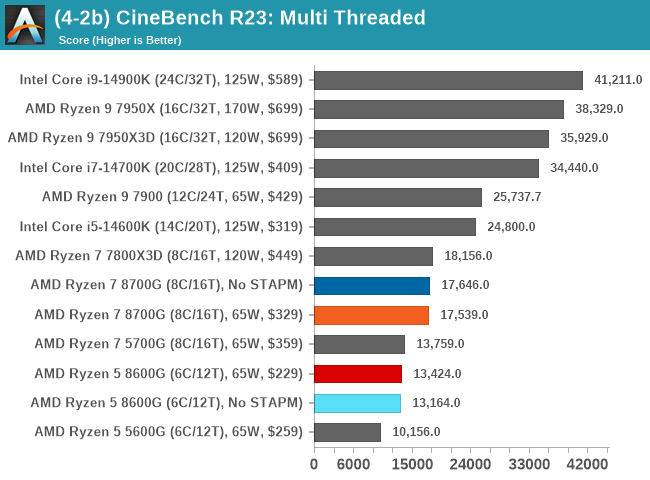
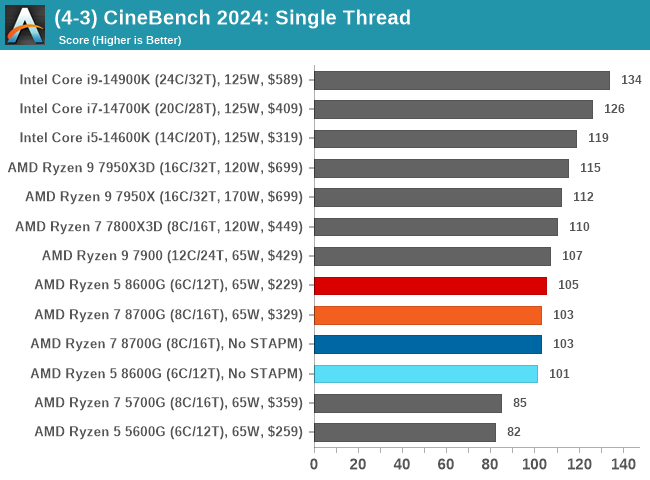
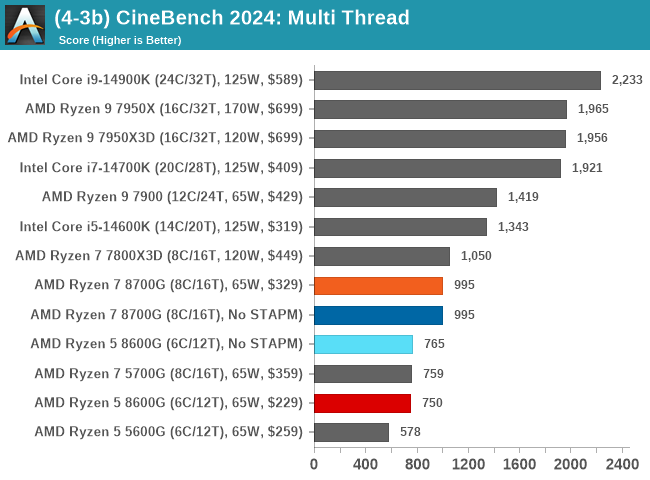

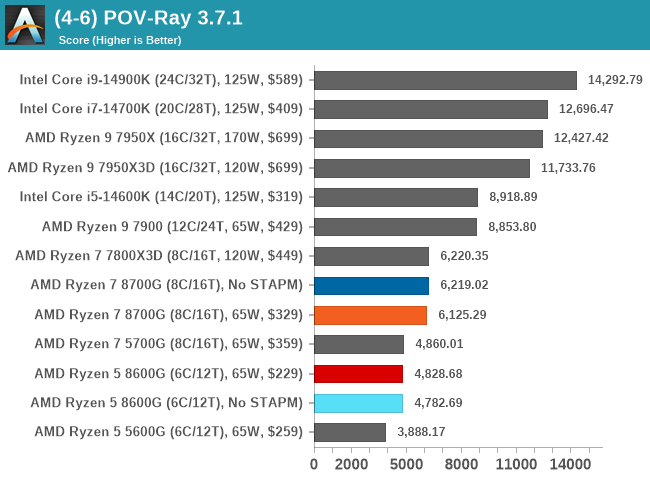
Another area where a mobile-based chip ported to a desktop doesn't quite match the bigger desktop chips is in rendering, a quintessential power and multi-threaded scenario where more cores and threads typically equate to higher performance. Both the Ryzen 7 8700G and Ryzen 5 8600G beat out the Ryzen 5000G series APUs, although the Ryzen 7 5700G consistently beats the Ryzen 5 8600G as we would expect from having two more cores with four more threads.
In our rendering tests without STAPM limitations, we saw notable gains in performance in Blender 3.6. The performance increase without sustained power loads being limited, we're seeing up to 7.5% better performance across the longer tests, with around 5% more performance in the shorter tests.










111 Comments
View All Comments
GeoffreyA - Wednesday, January 31, 2024 - link
On another point, I still think Anand's CPU reviews were better than Ian's. Ian was good but tended to get lost in the details, whereas Anand had an abstraction to his writing, and made computers inspiring, as if you were reading a story. Even the titles were memorable.TheinsanegamerN - Wednesday, January 31, 2024 - link
If you are going by steam, there are nearly as many sub 1080p as there are 1080p gamers. And those sub 1080p users would love the iGPU.If you dont like it, feel free not to read it. Or do your own review if you are so much smarter.
FWhitTrampoline - Tuesday, January 30, 2024 - link
Gamers Nexus has found an Issue with the Ryzen 8000G APUs in the form of some Mobile Variants of the 7000/Phoenix mobile processor firmware settings that should have been removed for the Desktop Ryzen 8000G series Phoenix derivatives. And that has something to do with Laptop/Handheld skin temperature regulation where in order to account for that in laptops/handhelds the processors are being trotted in the Desktop Ryzen 8000G SKUs as if that's in a mobile laptop/handheld from factor device! So watch GN's latest video from today and see that more re-testing may be in order there!nandnandnand - Tuesday, January 30, 2024 - link
It's Skin Temperature Aware Power Management (STAPM).Kinematics - Tuesday, January 30, 2024 - link
The 88 W peak draw is about 25 W above the 65 W TDP, not 35.mikato - Tuesday, January 30, 2024 - link
Are we not doing idle power consumption any more?t.s - Tuesday, January 30, 2024 - link
This depend significantly from PSU and motherboard you're using. anything x70 chipset 24ATX PSU will boost the idle power vs when using x20 and 12VO. But yes, I'm curious too with their setup idle power. My guess, around 50W -> 24ATX 1000W, 6950 GPU.mannen - Tuesday, January 30, 2024 - link
You missed to compare these against the Ryzen 5 7600 and the Ryzen 7 7700 CPUs.That would have been very interesting since they are equivalent (but desktop) parts with the same number of cores/threads. To compare to Ryzen 9 makes no sense since it's not within the same budget class.
I for example am interested in the 8600G, but also looking at the 7600 and keeping my old GPU. Since I don't game a lot, I can easily sacrifice the old GPU but I want to know how much CPU performance I'm giving up.
TheinsanegamerN - Wednesday, January 31, 2024 - link
Well the other commenters here are throwing huge temper tantrums over CPU benchmarks being included in this review, so you may be better off looking elsewhere.lorribot - Tuesday, January 30, 2024 - link
Would have been nice to see a comparison with discrete cards like a RTX2060/3060.